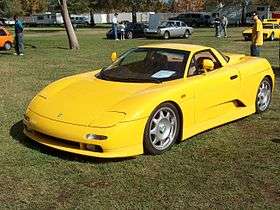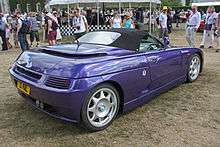De Tomaso Guarà
| De Tomaso Guarà | |
|---|---|
 | |
| Overview | |
| Manufacturer | De Tomaso |
| Production | 1993–2004 (50 produced) |
| Designer | Carlo Gaino (Synthesis Design) |
| Body and chassis | |
| Class | Sports car |
| Body style |
Barchetta Spider Coupé |
| Layout | RMR layout |
| Related | Maserati Barchetta |
| Powertrain | |
| Engine |
BMW M60 B40 V8 1993–1998 Ford/Visteon V8 1998–2004 |
| Transmission | 6-speed manual |
| Dimensions | |
| Wheelbase | 2,610 mm (102.8 in) |
| Length | 4,190 mm (165.0 in) |
| Width | 2,030 mm (79.9 in) |
| Height |
Coupé:1,200 mm (47.2 in) Barchetta:1,033 mm (40.7 in) |
| Curb weight |
Coupé BMW: 1,200 kg (2,646 lb) Coupé Ford: 1,400 kg (3086 lb) Barchetta: 1050 kg (2315 lb) |
The De Tomaso Guarà is a sports car and the last project of the founder and owner Alejandro de Tomaso put into the market. Presented at the 1993 Geneva Motor Show, the Guarà was available as a coupé and later as a spider and also as an open barchetta. The latter corresponds to the coupé but without roof and proper windscreen; just a small air deflector protects the passenger and the driver from the elements and the car had to be driven while wearing a helmet.
Development
The Guarà is based on the Maserati Barchetta Stradale prototype from 1991, a true race car from which a few conversions finally made it onto the public roads. The third model was the Guarà Spider, a convertible with a small canvas top; only four were produced; three as conversions by a local coachbuilder. Production of Spiders ceased when De Tomaso switched to the Ford engine as the new powerplant did not leave enough room for the canvas. As for the Maserati Barchetta the designer is Carlo Gaino of the "Synthesis Design".[1]


The first cars (mainly Coupés) were sold in 1994 and with some interruptions the Coupé and the Barchetta still were available (prepayment in full required) in 2005/2006 in Italy, Austria and Switzerland. However, it seems there were no cars built after 2004 when the company went into liquidation. The last car, ordered by an Austrian in 2004, was only delivered in 2011 after De Tomaso's liquidation was completed.[2]
Fibreglass, Kevlar, and other composites make the body shell, fitted to a backbone chassis.[3] The suspension is true Formula 1 and IndyCar technology with independent upper and lower wishbone with pushrod front and rear end suspension. The Guarà is known for its highly agile handling which makes it a bit too "nervous" for the average driver. The Guarà has no luggage space at all, the area under the front being taken up by the racing-style suspension. The large, distinct rims are by Marchesini.[4]
First, the Guarà was built using technology and interior parts from BMW but later all cars came equipped with Ford/Visteon (Canada) parts and engines. The Guarà was never homologated for US sale, although one engineless example was sent to the US importer of De Tomasos. However, at least one of the Ford powered Guarà coupés has been imported into the US and has California license plates.
Though sources vary, approximately fifty total were built. 10 (or up to 12) were barchettas, 4 spiders, and the remainder were coupés.[4]
- Engines
1993–1998
- BMW M60 B40 light alloy V8
- 4.0 L, 32-valve
- 208 kW (283 PS; 279 hp)
- Note: a 304 PS (300 hp/224 kW) version was announced but most likely just a prototype was built with that engine
- 6-speed manual
1998–2004
- Ford/Visteon light alloy V8
- 4.6 L, 32-valve
- 320 hp (239 kW)
- Supercharged engines producing 375 and 430 hp (280 and 321 kW) were announced but never built
- 6-speed manual
- Maximum speed
- Coupé: 270 km/h (168 mph)
- Barchetta: 275 km/h (171 mph)
- Acceleration 0–100 km/h (62 mph): approximately 5.0 s
- Weight
- Coupé: 1400 kg (3086 lb)
- Barchetta: 1050 kg (2315 lb)
- Prices in 2005
- Coupé: €118000
- Barchetta: €104000
References
- ↑ "De Tomaso - Guarà". Synthesis Design. October 2002.
- ↑ Lange, Hans-Karl (2012). "Das Beben grollt noch: Das Ende von De Tomaso" [The quake still rumbles: The end of De Tomaso]. Oldtimer Markt (in German). Germany: Vereinigte Fachverlage (8): 53.
- ↑ Wouter Melissen (30 June 2008). "DeTomaso Guarà". www.ultimatecarpage.com. Retrieved 14 September 2013.
- 1 2 Giordanelli, Roberto (March 2005). "De Tomaso Guara: The Enigmatic Supercar". Auto Italia. Virgin Media.
External links
- designer of De Tomaso Guarà
- De Tomaso official Web Site NO LONGER WORKING
- De Tomaso Startpagina Site
- Test drive (in German)
| De Tomaso Modena S.p.A. car timeline, 1960s–2010s | ||||||||||||||||||||||||||||||||||||||||||||||||||
|---|---|---|---|---|---|---|---|---|---|---|---|---|---|---|---|---|---|---|---|---|---|---|---|---|---|---|---|---|---|---|---|---|---|---|---|---|---|---|---|---|---|---|---|---|---|---|---|---|---|---|
| Type | 1960s | 1970s | 1980s | 1990s | 2000s | |||||||||||||||||||||||||||||||||||||||||||||
| 0 | 1 | 2 | 3 | 4 | 5 | 6 | 7 | 8 | 9 | 0 | 1 | 2 | 3 | 4 | 5 | 6 | 7 | 8 | 9 | 0 | 1 | 2 | 3 | 4 | 5 | 6 | 7 | 8 | 9 | 0 | 1 | 2 | 3 | 4 | 5 | 6 | 7 | 8 | 9 | 0 | 1 | 2 | 3 | 4 | 5 | 6 | 7 | 8 | 9 | |
| RMR | Vallelunga | Mangusta | Pantera | Guarà | ||||||||||||||||||||||||||||||||||||||||||||||
| FR Sedan | Deauville | |||||||||||||||||||||||||||||||||||||||||||||||||
| FR Coupé | Longchamp | Biguà | ||||||||||||||||||||||||||||||||||||||||||||||||